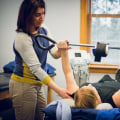Physical therapy (PT) is an essential part of recovery and rehabilitation for many individuals dealing with injuries, surgeries, or chronic conditions. Whether you’re recovering from a sports injury, surgery, or a medical condition like arthritis, your first session might seem intimidating. Knowing what to expect can ease any anxieties and help you make the most of the experience. A physical therapy session typically includes several key steps designed to improve your strength, flexibility, and overall function.
Initial Evaluation
The first step in your PT session will be an evaluation. This is crucial for your physical therapist to understand your specific needs, goals, and limitations. The therapist will review your medical history, assess your range of motion, strength, balance, and flexibility, and may perform other tests to determine where you need the most support. You will also discuss your pain levels, daily activities, and what you hope to achieve through therapy. This evaluation helps set a baseline to track your progress throughout your sessions.
Goal Setting
Once the evaluation is complete, the physical therapist will work with you to establish goals. These goals will vary depending on your condition. For example, if you’ve had surgery, your goal may be to regain mobility in the affected area. If you are an athlete recovering from an injury, your goal might be to restore your performance level and prevent further injuries. The therapist will design a customized treatment plan based on your individual goals, ensuring that each session is productive and focused.
Treatment Techniques
During your session, your therapist may employ a variety of treatment techniques to address your specific condition. These can include manual therapy, which involves hands-on techniques to mobilize muscles and joints, and therapeutic exercises that focus on building strength and improving mobility. Many physical therapists also incorporate equipment like resistance bands, stability balls, or weights to enhance your exercise routine. Treatment can also involve modalities such as heat or cold therapy, ultrasound, and electrical stimulation to manage pain and inflammation. One unique and growing aspect of physical therapy is the use of adjunct therapies such as Healing Heat Therapy - Infrared Saunas, which may complement traditional methods by improving circulation, reducing pain, and aiding in muscle recovery.
Exercise and Stretching
A large portion of your physical therapy session will likely involve exercise. These exercises will be tailored to your specific needs and designed to improve your strength, endurance, balance, and coordination. Your therapist will guide you through each exercise, ensuring you use proper form to prevent injury. The exercises may start off simple and progress in difficulty as you regain strength and flexibility. Stretching is also an integral part of physical therapy, helping to relieve tension in tight muscles and improve your range of motion.
Education and Home Exercise Program
In addition to the hands-on treatment and exercises performed during your session, physical therapists place a strong emphasis on education. You will learn about body mechanics, posture, and ergonomics to prevent further injury. Your therapist may teach you techniques to manage pain and suggest modifications to daily activities to avoid aggravating your condition. Most importantly, you’ll be given a home exercise program. This program typically consists of stretches and exercises that complement the work you do in the clinic. Consistency with your home program is crucial for making progress between sessions and ensuring long-term success.
Progress Tracking
Throughout your sessions, your therapist will closely monitor your progress. They may re-evaluate your condition at regular intervals to adjust your treatment plan as needed. As you improve, your therapist may increase the intensity or complexity of your exercises to continue challenging your body and enhancing recovery. Open communication is key here—let your therapist know how you’re feeling and if you’re experiencing any new pain or discomfort, as this will allow them to adjust your treatment accordingly.
Pain Management
Managing pain is a major focus during physical therapy sessions, especially in the early stages of rehabilitation. Your therapist may use different pain-relief techniques such as massage, ice therapy, or even more advanced methods like ultrasound therapy or electrical stimulation. They’ll also guide you on how to manage pain at home, ensuring that you’re not overloading your muscles or joints during daily activities. It’s essential to remember that some discomfort is normal during therapy, especially as you push your body to regain strength and flexibility, but sharp or severe pain should be reported immediately.
The Road to Recovery
Consistency is key in physical therapy. The number of sessions you’ll need depends on the severity of your condition and how diligently you follow your treatment plan. Recovery is not always linear, and you may experience days when progress feels slower than others. However, sticking with the program, communicating openly with your therapist, and following through with your home exercises will help you achieve the best results. Physical therapy sessions are designed not just to treat the immediate issue but also to equip you with the tools and knowledge to maintain your health and prevent future injuries.
In conclusion, a physical therapy session is a highly personalized and multifaceted process aimed at helping you regain functionality and reduce pain. With the guidance of a skilled therapist, you’ll work towards your goals, improve your physical health, and learn valuable techniques to maintain your progress long after your therapy ends.







